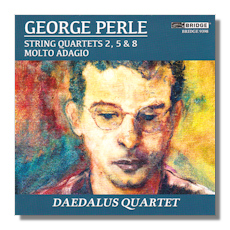
The Internet's Premier Classical Music Source
Related Links
- Perle Reviews
- Latest Reviews
- More Reviews
-
By Composer
-
Collections
DVD & Blu-ray
Books
Concert Reviews
Articles/Interviews
Software
Audio
Search Amazon
Recommended Links
Site News
 CD Review
CD Review
George Perle

String Quartets, Volume 1
- String Quartet #2 in D minor, Op. 14
- String Quartet #5
- String Quartet #8 "Windows of Order"
- Molto Adagio
Daedalus Quartet
Bridge 9398
George Perle (1915-2009) is as well known for his writings on music theory (especially "Serial Composition and Atonality: An Introduction to the Music of Schoenberg, Berg, and Webern" (ISBN-10: 0520074300; ISBN-13: 978-0520074309) and "Twelve-Tone Tonality" (ISBN-10: 0520201426; ISBN-13: 978-0520201422) – both from the University of California Press) as for his compositions. On this new CD from Bridge are presented four of Perle's works for strings in Volume I of a series which promises all such works by the composer.
They're played with an excellent balance of sensitivity, conviction and insight by the young members of the Daedalus Quartet. They specialize in new and recent music in this repertoire. For all they are four gifted individual musicians, their ensemble playing is very impressive – the slower passages of the already slow Molto Adagio [tr.8], for instance. On first listening it's hard to discern whether the gentleness, calmness and utter control of the players is in their nature anyway. Or whether it's a response to and respect for the deceptive simplicity of Perle's writing, which seems to owe more to (French) Romantic string writing than the Second Viennese School.
Indeed, Perle eschewed Serialism and marked atonality. On the surface, his music is linear and unexcitedly melodic. In fact, it is structured with more than a passing acknowledgement to the ideas developed by Bartók and Stravinsky as well as the angularity and tonal adventurousness of Schoenberg, and Berg. It is to the credit of the Daedalus Quartet that they can expose so well this rather anomalous situating of the composer's work.
This is not to say that the players concentrate on the sounds of the strings as sounds only. Nor that they turn their playing into a mathematical or purely theoretical exercise. There is passion and commitment: listen to the wandering slow third movement of the Second Quartet in D minor [tr.3], for instance. And the finely-crafted first movement of the Fifth [tr.4], which immediately follows. Inbuilt in the latter appear to be hesitation, repetition and tentativeness. In fact, one will perceive development, change, concentration. The players convey all of these qualities; as well as a true sense of purpose and originality.
The almost-faltering (though never annoying, halting or stuttering) motifs of the Fifth re-emerge in the third movement [tr.6]. But the Daedalus Quartet approach it in such a way as to reveal the holistic structure, Perle's carefully-thought approach to design, not sound for sound's sake.
String Quartet #8 (which has the title "Windows of Order") is the longest work on this CD. It's also the most recent, dating from 1987/88. (The Second dates from 1942, the Fifth from 1967, Molto Adagio from 1938.) It shares the same apparently anodyne first impact as the other works on the CD. But even minimally closer listening to the steady hands of the Daedalus Quartet reveals subtleties and nuances which quickly and conclusively overturn challenges that the music is either insipid or essentially unadventurous. It's captivating. The playing here is full of color and gradation, shading and finesse without either sleight of musical hand or unnecessary compensation for apparent simplicity by the Daedalus.
Molto Adagio is just that. It's longer too – at twelve and a half minutes – and also very compelling. It's perhaps this piece that encourages one to classify George Perle as a composer first and theoretician second. It's the playing of the Daedalus Quartet [Min-Young Kim & Matilda Kaul (violins), Jessica Thompson (viola), Thomas Kraines (cello)] here which confirm our understanding that the two roles in musical life so healthily and successfully complement each other. Redolent in places of Bartók (his second String Quartet) and even Beethoven's late quartets (especially, Op. 132), it's not a derivative work at all because it has the courage to unfold with its own (ternary) logic and express just what Perle wants it to express without either compromise or becoming clogged in precedent.
An apt allusion which captures the delicate, deft yet uncompromising style of their playing would be to the dance. There is an unforced grace which makes Perle's dovetailing, overlapping concentration on the horizontal as much as the textural so full of impact. These four players move inside the music, rather than pull it off the page and present it to us. Surely a mark of great string quartet playing.
The acoustic is close and focused. There is little atmosphere, which is all to the good. It's the essence of this strangely effective music that one remembers. The booklet that comes with the CD is full of relevant and useful information – if printed in a font size that's really too small to read comfortably. If you've read Perle's writings on (modern) music, this CD will do more than intrigue you; it will delight and stimulate. If your purpose is to hear good contemporary string quartet repertoire, albeit from a composer who's not considered a member of the mainstream, or avant-garde, played with great style and skill, then this is a CD well worth investigating.
Copyright © 2013, Mark Sealey




















